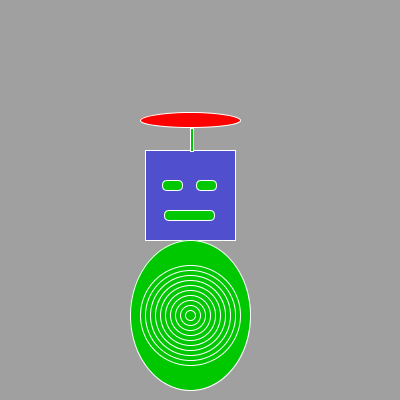Jan Dropmann (talk | contribs) No edit summary |
Jan Dropmann (talk | contribs) No edit summary |
||
| Line 11: | Line 11: | ||
===== Screenshots ===== | ===== Screenshots ===== | ||
[[File:Twitterbird.png|400px|thumb|left]] | |||
<br style="clear:both"> | |||
[[File: | [[File:Metalrain.png|400px|thumb|left]] | ||
<br style="clear:both"> | |||
===== Source Code ===== | |||
<source lang="python"> | |||
"""importing the librarys needed for image processing""" | |||
from PIL import Image, ImageFilter, ImageColor, ImageOps #Python Image Libray: adds image processing capabilities to your Python interpreter | |||
import numpy as np #nummerical python used for calculating huge arrays and matrices with numeric data | |||
import colorsys #contains function for converting between different Colormodes as RGB and other | |||
import random #contains different random number generators | |||
[[File: | import sys #sys module offers constants, functions and methodes from the python interpreter | ||
class ImageProcessor: | |||
"""Using Image Module""" | |||
#just flips the image upsidedown | |||
def flip(self, img): | |||
return img.transpose(Image.FLIP_TOP_BOTTOM) | |||
#rotates the image with a specific degree (e.g 90) | |||
def rotate(self, img): | |||
return img.transpose(Image.ROTATE_90) | |||
"""Using ImageOps Module""" #Image Operations | |||
#turning the image into an one chanel (L) grayscale image | |||
def grayscale(self, img): | |||
return ImageOps.grayscale(img) | |||
#substitute different colors to the white and black pixels. It expact a RGB tuple for each of them. (Only works with RGB colormode) | |||
def color_change(self, img): | |||
return ImageOps.colorize(img, (255, 0, 0),(0, 0, 255)) | |||
"""Using ImageFilter Module""" | |||
#applying gaussian blur to the image. Changing the radius(intensity) of the blur | |||
def blur(self, img): | |||
return img.filter(ImageFilter.GaussianBlur(radius=4)) | |||
#applying contour to the image | |||
def contour(self, img): | |||
return img.filter(ImageFilter.CONTOUR) | |||
#applying a edge enhancement to the image | |||
def edge(self, img): | |||
return img.filter(ImageFilter.EDGE_ENHANCE_MORE) | |||
################################################################ | |||
# some more advanced image processing # | |||
################################################################ | |||
# shifting pixels with a specific amount | rows or columns | |||
def shifting_pixels(self, img, fn=None, amount=10, horizontal=True): | |||
if fn is None: | |||
fn = shift_list | |||
# getting the imagine demention > full image | |||
ymax, xmax = img.size | |||
# converting the input (image) into an array with numpy | |||
a1 = np.asarray(img) | |||
a2 = np.zeros((xmax, ymax, 3)) | |||
# shifting columns of pixels | |||
if horizontal is True: | |||
# iterate over half(xmax / 2) of the rows | any other array of the image could be selected full image would be xmax /1 | |||
for x in range(xmax / 2): | |||
#define the amount the pixels should be moved with a random selector in a number array("amount" can be replaced by any number) | |||
d = random.randint(-amount, amount) | |||
row = a1[x,:,:] | |||
a2[x,:,:] = fn(row, d) | |||
# iterate over the other half | |||
for x in range(xmax / 2, xmax): | |||
a2[x,:,:] = a1[x,:,:] | |||
# sorting rows of pixels | |||
else: | |||
# iterate over half(ymax / 2) of the columns | |||
for y in range(ymax / 2): | |||
d = random.randint(-amount, amount) | |||
col = a1[:,y,:] | |||
a2[:,y,:] = fn(col, d) | |||
# iterate over the other half | |||
for y in range(ymax / 2, ymax): | |||
a2[:,y,:] = a1[:,y,:] | |||
# turn the numpy array back into an image | |||
a2 = np.uint8(a2) | |||
out = Image.fromarray(a2) | |||
# return the result (image) | |||
return out | |||
def shift_list(self, lst, amount): | |||
# make sure we got lists | |||
lst = list(lst) | |||
# combine slices | |||
lst = lst[amount:] + lst[:amount] | |||
return lst | |||
#pixel sorting using numpy | |||
def sort(self, img, fn=None, horizontal=True, reverse=False): | |||
# get image dimensions > full image |other demensions are possible | |||
ymax, xmax = img.size | |||
#you can apply brightness, redness, yellowness and hue to fn as they are defined below | |||
if fn is None: | |||
fn = self.brightness | |||
else: | |||
fn = self.redness | |||
# lets work with arrays and numpy (changing the image into numpy usable data) | |||
a1 = np.asarray(img) | |||
a2 = np.zeros((xmax, ymax, 3)) | |||
# sorting rows(x) of pixels | |||
if horizontal is True: | |||
# iterate over all the rows(xmax) or any other amount of the image (e.g half (xmax / 2)) | |||
for x in range(xmax / 1): | |||
row = a1[x,:,:] | |||
a2[x,:,:] = sorted(row, key=fn, reverse=reverse) | |||
for x in range(xmax / 1, xmax): | |||
a2[x,:,:] = a1[x,:,:] | |||
else: | |||
# iterate over all columns(y) or any other amount of the image (e.g half (ymax / 2)) | |||
for y in range(ymax / 1): | |||
col = a1[:,y,:] | |||
a2[:,y,:] = sorted(col, key=fn, reverse=reverse) | |||
# iterate over the other half | |||
for y in range(ymax / 1, ymax): | |||
a2[:,y,:] = a1[:,y,:] | |||
# turn the numpy array back into an image | |||
a2 = np.uint8(a2) | |||
out = Image.fromarray(a2) | |||
# return the result (image) | |||
return out | |||
################################################################ | |||
#defining some further image processings which are colled above# | |||
#and will determine the order of colors # | |||
################################################################ | |||
def brightness(self, c): | |||
""" assign a value to each color """ | |||
r, g, b = c | |||
return 0.01 * r + 0.587 * g + 0.114 * b | |||
def redness(self, c): | |||
""" return the amount of red """ | |||
r, g, b = c | |||
return r | |||
def yellowness(self, c): | |||
""" return the amount of yellow """ | |||
r, g, b = c | |||
return r * 0.5 + g * 0.5 | |||
def hue(self, c): | |||
""" return the hue of some color """ | |||
r, g, b = c | |||
h, s, v = colorsys.rgb_to_hsv(float(r), float(g), float(b)) | |||
return h | |||
################################################################ | |||
# trying new stuff # | |||
################################################################ | |||
# Sorts a given row of pixels | |||
def sort_interval(self, interval): | |||
if interval == []: | |||
return [] | |||
else: | |||
return(sorted(interval, key = lambda x: x[0] + x[1] + x[2])) | |||
</source> | |||
==== Little Bot with Processing ==== | |||
'''Created a simple Bot and an animated GIF''' | |||
===== Screenshots ===== | |||
[[File:First robot.png | 80 x80px| |left ]] | |||
[[File:Robot.gif | 100 x100px| |left ]] | |||
Revision as of 12:47, 28 June 2015
Welcome to my new Wiki-Page
-Name: Jan Dropmann -Bachelor: Media Studies
Twitter Bot
Takes an Image, process it and post it on Twitter
Screenshots
Source Code
"""importing the librarys needed for image processing"""
from PIL import Image, ImageFilter, ImageColor, ImageOps #Python Image Libray: adds image processing capabilities to your Python interpreter
import numpy as np #nummerical python used for calculating huge arrays and matrices with numeric data
import colorsys #contains function for converting between different Colormodes as RGB and other
import random #contains different random number generators
import sys #sys module offers constants, functions and methodes from the python interpreter
class ImageProcessor:
"""Using Image Module"""
#just flips the image upsidedown
def flip(self, img):
return img.transpose(Image.FLIP_TOP_BOTTOM)
#rotates the image with a specific degree (e.g 90)
def rotate(self, img):
return img.transpose(Image.ROTATE_90)
"""Using ImageOps Module""" #Image Operations
#turning the image into an one chanel (L) grayscale image
def grayscale(self, img):
return ImageOps.grayscale(img)
#substitute different colors to the white and black pixels. It expact a RGB tuple for each of them. (Only works with RGB colormode)
def color_change(self, img):
return ImageOps.colorize(img, (255, 0, 0),(0, 0, 255))
"""Using ImageFilter Module"""
#applying gaussian blur to the image. Changing the radius(intensity) of the blur
def blur(self, img):
return img.filter(ImageFilter.GaussianBlur(radius=4))
#applying contour to the image
def contour(self, img):
return img.filter(ImageFilter.CONTOUR)
#applying a edge enhancement to the image
def edge(self, img):
return img.filter(ImageFilter.EDGE_ENHANCE_MORE)
################################################################
# some more advanced image processing #
################################################################
# shifting pixels with a specific amount | rows or columns
def shifting_pixels(self, img, fn=None, amount=10, horizontal=True):
if fn is None:
fn = shift_list
# getting the imagine demention > full image
ymax, xmax = img.size
# converting the input (image) into an array with numpy
a1 = np.asarray(img)
a2 = np.zeros((xmax, ymax, 3))
# shifting columns of pixels
if horizontal is True:
# iterate over half(xmax / 2) of the rows | any other array of the image could be selected full image would be xmax /1
for x in range(xmax / 2):
#define the amount the pixels should be moved with a random selector in a number array("amount" can be replaced by any number)
d = random.randint(-amount, amount)
row = a1[x,:,:]
a2[x,:,:] = fn(row, d)
# iterate over the other half
for x in range(xmax / 2, xmax):
a2[x,:,:] = a1[x,:,:]
# sorting rows of pixels
else:
# iterate over half(ymax / 2) of the columns
for y in range(ymax / 2):
d = random.randint(-amount, amount)
col = a1[:,y,:]
a2[:,y,:] = fn(col, d)
# iterate over the other half
for y in range(ymax / 2, ymax):
a2[:,y,:] = a1[:,y,:]
# turn the numpy array back into an image
a2 = np.uint8(a2)
out = Image.fromarray(a2)
# return the result (image)
return out
def shift_list(self, lst, amount):
# make sure we got lists
lst = list(lst)
# combine slices
lst = lst[amount:] + lst[:amount]
return lst
#pixel sorting using numpy
def sort(self, img, fn=None, horizontal=True, reverse=False):
# get image dimensions > full image |other demensions are possible
ymax, xmax = img.size
#you can apply brightness, redness, yellowness and hue to fn as they are defined below
if fn is None:
fn = self.brightness
else:
fn = self.redness
# lets work with arrays and numpy (changing the image into numpy usable data)
a1 = np.asarray(img)
a2 = np.zeros((xmax, ymax, 3))
# sorting rows(x) of pixels
if horizontal is True:
# iterate over all the rows(xmax) or any other amount of the image (e.g half (xmax / 2))
for x in range(xmax / 1):
row = a1[x,:,:]
a2[x,:,:] = sorted(row, key=fn, reverse=reverse)
for x in range(xmax / 1, xmax):
a2[x,:,:] = a1[x,:,:]
else:
# iterate over all columns(y) or any other amount of the image (e.g half (ymax / 2))
for y in range(ymax / 1):
col = a1[:,y,:]
a2[:,y,:] = sorted(col, key=fn, reverse=reverse)
# iterate over the other half
for y in range(ymax / 1, ymax):
a2[:,y,:] = a1[:,y,:]
# turn the numpy array back into an image
a2 = np.uint8(a2)
out = Image.fromarray(a2)
# return the result (image)
return out
################################################################
#defining some further image processings which are colled above#
#and will determine the order of colors #
################################################################
def brightness(self, c):
""" assign a value to each color """
r, g, b = c
return 0.01 * r + 0.587 * g + 0.114 * b
def redness(self, c):
""" return the amount of red """
r, g, b = c
return r
def yellowness(self, c):
""" return the amount of yellow """
r, g, b = c
return r * 0.5 + g * 0.5
def hue(self, c):
""" return the hue of some color """
r, g, b = c
h, s, v = colorsys.rgb_to_hsv(float(r), float(g), float(b))
return h
################################################################
# trying new stuff #
################################################################
# Sorts a given row of pixels
def sort_interval(self, interval):
if interval == []:
return []
else:
return(sorted(interval, key = lambda x: x[0] + x[1] + x[2]))
Little Bot with Processing
Created a simple Bot and an animated GIF



